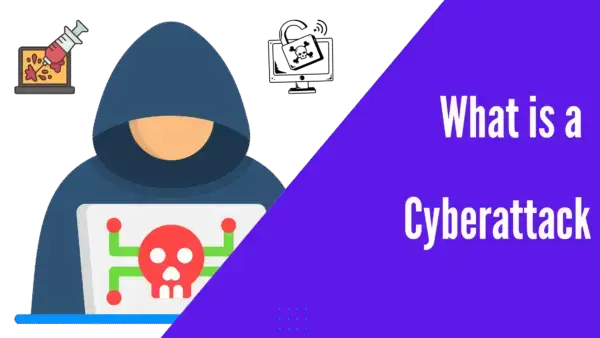Last updated on August 13th, 2025 at 02:32 pm

If you are here, chances are you wish to know what a cyberattack is and how to avoid it.
In recent years, cyberattacks have become a major problem for individuals and, by extension, governments around the world. As such, it is imperative that we become educated about what cyberattacks are and how to prevent them.
Here are the topics that we will be covering in today’s article
- What is a cyberattack;
- Four common types of cyberattacks,
- One example of a cyberattack within the United States; and
- 10 things that can be done to protect yourself from cyberattacks.
What is a cyberattack? | Define the term cyberattack
A cyberattack is a deliberate attempt to access restricted files on a computer, computing system, or network. The main goal of these cybercriminals is to steal, expose, alter, disable, or destroy confidential information, applications, or other assets.
Four common types of cyber attacks
There are many different forms of cyberattacks that occur worldwide. Four common types are;
- Malware: This is a type of computer program that exploits and harms any programable device or network. Some types of malware are viruses, worms, trojans, ransomware, and spyware. Malware can steal, encrypt, hijack data, delete or alter core computing functions, and spy on your computer without your permission.
- Phishing: A phishing attack is the act of sending misleading information such as emails as a trusted source to individuals to obtain their personal or banking information, passwords, and credit card numbers.
- Ransomware is a type of computer program that encrypts user files. The attacker then demands a ransom from the user to restore access to the files.
- Password attacks: Password attacks refer to attempts by a cybercriminal to obtain user passwords often done through brute force, dictionary attacks, or other methods.
One example of a cyber attack within the United States
One example of a cyberattack committed in the United States is the Equifax data breach in the year 2017.
Hackers accessed the personal information of 147 million individuals, about 44% of the population of the United States. The data they obtained included their names, social security numbers, birthdates, addresses, and, in some cases, license numbers and credit card details.
This breach severely affected the company and customers while showing the critical need for cybersecurity.
10 things to do to protect yourself from cyber attacks
10 Things that you can do to protect yourself from cyberattacks are:
- Create strong passwords.
- Utilize multifactor authentication to enhance your computer security. This requires multiple forms of verification.
- Use reputable antivirus software to detect and remove malware efficiently.
- Regularly update your operating system (OS) and other software to protect against exploitation and vulnerabilities.
- Do not click on suspicious links or e-mails that require your personal information without verifying their source. This could be an act of phishing.
- Encrypt and use strong passwords to protect your network from unauthorized access.
- Back up important information to the cloud or an external storage device to guard against data loss from cyberattacks.
- Educate employees on how to locate potential threats to your computer system or network.
- Utilize a firewall to monitor incoming and outgoing traffic.
- Minimize sharing personal information online to protect yourself from identity theft and social engineering attacks.
Note well, there are other computer misuses that fall under the heading of cyberwarfare rather than cyber attack. While these two terms interrelate, cyber warfare is a much broader term that involves the use of the Internet to carry out attacks against nations.
One cyberwarfare that does not fall under the umbrella of cyberattack is propaganda. Under cyberattack, cyberwarfare is more of an effort to use the internet to manipulate minds rather than damage computer equipment.
 Skip to content
Skip to content 